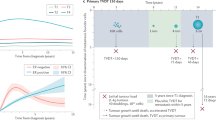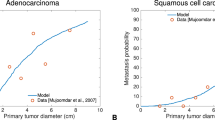Abstract
Little is known about the natural history of cancer and its evolution to metastasis. Paget was the first to postulate the important role played by microenvironment in metastasis progression. Since, the concept of his “seed and soil” theory has been supported and confirmed. Understanding the chronology and natural course that underlie metastasis is mandatory to deepen this concept and to progress in the development of novel therapeutic strategies. A total of 413 patients who underwent treatment for brain metastasis (2013–2016) were included. The identification of previous and newly diagnosed metastasis was made during the clinical and imaging follow-up. We identified 910 metastases in our series. The 2-, 5-, and 10-year survival estimates were 80% (SD 2), 59.1% (3), and 36% (4), respectively. The median time for first metastasis, referred as metastasis-free survival (MFS) was 15.2 months (SD 1.47). MFS were determined for each metastasis location and were as follows: 7.2 months (SD 8.0) for bone, adrenal 8.4 months (SD 9.4) for adrenal, 13.2 months (SD 1.7) for brain, 14.6 months (SD 5.4) for liver, 25.7 months (SD 11.7) for pleura, 27.7 months (SD 15.9) for peritoneum, 29.8 months (SD 7.2) for spine, 30.2 months (SD 5.2) for lungs, and 54.2 months (SD 12.4) for skin (p < 0.009 log rank). We identified a metastatic timeline process for breast cancer (p < 0.0001 log rank (Mantel–Cox)) and furthermore according to breast subtype cancer (p < 0.0001). We suggest that in addition to Paget’s theory, a timeline and a natural history of metastasis exist in patients with cancer. We suppose that some, but not all, primary cancers follow chronological and scheduled metastatic processes to invade organs.



Similar content being viewed by others
References
Hanahan D, Weinberg RA. The hallmarks of cancer. Cell. 2000;100:57–70.
Spratt JS, Meyer J, Spratt JA. Rates of growth of human neoplasms: part II. J Surg Oncol. 1996;61:68–83.
Paget S. The distribution of secondary growths in cancer of the breast. Lancet. 1889;1:571–3.
Sugarbaker D. Organ selectivity of experimentally induced metastases in rats. Cancer. 1952;5:606–12.
Kinsey DL. An experimental study of preferential metastasis. Cancer. 1960;13:674–6.
Hart IR, Fidler IJ. Role of organ selectivity in the determination of metastatic patterns of B16 melanoma. Cancer Res. 1980;40:2281–7.
Chambers AF, Groom AC, Mac Donald IC. Dissemination and growth of cancer cells in metastatic sites. Nat Rev Cancer. 2002;2:563–72.
Gupta G, Massague J. Cancer metastasis: building a framework. Cell. 2006;127:679–95.
Ewing J. Neoplastic diseases. Philadelphia: WB Saunders; 1928.
Turner GA. Surface properties of the metastatic cell. Invasion Metastasis. 1982;2:197–216.
Reading CL, Hutchins JF. Carbohydrate structure in tumor immunity. Cancer Metastasis Rev. 1985;4:221–60.
Raz A, Lotan R. Endogenous galactoside-binding lectins: a new class of functional tumor cell surface molecules related to metastasis. Cancer Metastasis Rev. 1987;6:433–52.
Hujanen ES, Terranova VP. Migration of tumor cells to organ derived chemoattractants. Cancer Res. 1985;45:3517–21.
Nicolson GL. Cancer metastasis: tumor cell and host organ properties important in metastasis to specific secondary sites. Biochim Biophys Acta. 1988;948:175–224.
Nicolson GL. Organ specificity of tumor metastasis: role of preferential adhesion, invasion and growth of malignant cells at specific secondary sites. Cancer Metastasis Rev. 1988;7:143–88.
Nicolson GL, Dulski KM. Organ specificity of metastatic tumor colonization is related to organ-selective growth properties of malignant cells. Int J Cancer. 1986;38:289–94.
Weiss L. Dynamic aspects of cancer cell populations in metastasis. Am J Pathol. 1979;97:601–8.
Fidler IJ. Rationale and methods for the use of nude mice to study the biology and therapy of human cancer metastasis. Cancer Metastasis Rev. 1986;5:29–49.
Hart I. Seed and soil’ revisited: mechanisms of site-specific metastasis. Cancer Metastasis Rev. 1982;1:5–16.
Klein G. Foulds’ dangerous idea revisited: the multistep development of tumors 40 years later. Adv Cancer Res. 1998;72:1–23.
Fearon ER, Vogelstein B. A genetic model for colorectal tumorigenesis. Cell. 1990;61:759–67.
Riihimäki M, Hemminki A, Fallah M, Thomsen H, Sundquist K, Sundquist J, et al. Metastatic sites and survival in lung cancer. Lung Cancer. 2014;86(1):78–84. doi:10.1016/j.lungcan.2014.07.020 (Epub 2014 Aug 2).
Klein CA. Parallel progression of primary tumours and metastasis. Nat Rev Cancer. 2009;9:302–12.
Weinstein I, Joe AK. Mechanisms of disease: oncogene addiction, a rationale for molecular targeting in cancer therapy. Nat Clin Pract Oncol. 2006;3:448–57.
Brabletz T. To differentiate or not routes towards metastasis. Nat Rev Cancer. 2012;12(6):425–36. doi:10.1038/nrc3265.
Elsawaf Z, Sinn H. Triple-negative breast cancer: clinical and histological correlations. Breast Care. 2011;6:273–8.
Laurberg T, Alsner J, Tramm T, Jensen V, Lyngholm C, Christiansen P, et al. Impact of age, intrinsic subtype and local treatment on long-term local regional recurrence and breast cancer mortality among low-risk breast cancer patients. Acta Oncol. 2016;16:1–9.
Szekely B, Nagy ZI, Farago Z, Kiss O, Lotz G, Kovacs KA, et al. Comparison of immunophenotypes of primary breast carcinomas and multiple corresponding distant metastasis: an autopsy study of 25 patients. Clin Exp Metastasis. 2017;34(1):103–13. doi:10.1007/s10585-016-9830-x (Epub 2016 Nov 24).
Niwińska A, Rudnicka H, Murawska M. Breast cancer leptomeningeal metastasis: propensity of breast cancer subtypes for leptomeninges and the analysis of factors influencing survival. Med Oncol. 2013;30(1):408. doi:10.1007/s12032-012-0408-4.
Rakha EA, Elsheikh SE, Aleskandarany MA, Habashi HO, Green AR, Powe DG, et al. Triple-negative breast cancer: distinguishing between basal and nonbasal subtypes. Clin Cancer Res. 2009;15:2302–10. doi:10.1158/1078-0432.CCR-08-2132.
Robinson MJ, Cobb MH. Mitogen-activated protein kinase pathways. Curr Opin Cell Biol. 1997;9:180–6.
Wellbrock C, Karasarides M, Marais R. The RAF proteins take centre stage. Nat Rev Mol Cell Biol. 2004;5:875–85.
Wan PT, Garnett MJ, Roe SM, Lee S, Niculescu-Duvaz D, Good VM, et al. Mechanism of activation of the RAF–ERK signaling pathway by oncogenic mutations of B-RAF. Cell. 2004;116:855–67.
Ugurel S, Thirumaran RK, Bloethner S, Gast A, Sucker A, Mueller-Berghaus J, et al. B-RAF and N-RAS mutations are preserved during short time in vitro propagation and differentially impact prognosis. PLoS ONE. 2007;2:e236.
Schneider F, Derrick V, Davison JM, Strollo D, Incharoen P, Dacic S. Morphological and molecular approach to synchronous non-small cell lung carcinomas: impact on staging. Mod Pathol. 2016;29(7):735–42. doi:10.1038/modpathol.2016.66.
Spratt JS, Spratt TL. Rates of growth of pulmonary metastasis and host survival. Ann Surg. 1964;159:161–71.
Chanvorachote P, Chamni S, Ninsontia C, Phiboonchaiyanan PP. Potential anti-metastasis natural compounds for lung cancer. Anticancer Res. 2016;36(11):5707–17.
Ulmer A, Schmidt-Kittler O, Fischer J, Ellwanger U, Rassner G, Riethmüller G, et al. Immunomagnetic enrichment, genomic characterization, and prognostic impact of circulating melanoma cells. Clin Cancer Res. 2004;10:531–7.
Cristofanilli M, Budd GT, Ellis MJ, Stopeck A, Matera J, Miller MC, et al. Circulating tumor cells, disease progression, and survival in metastatic breast cancer. N Engl J Med. 2004;351:781–91.
Dawood S, Broglio K, Valero V, Reuben J, Handy B, Islam R, et al. Circulating tumor cells in metastatic breast cancer: from prognostic stratification to modification of the staging system? Cancer. 2008;113:2422–30.
Navin NE. The first five years of single-cell cancer genomics and beyond. Genome Res. 2015;25:1499–507.
Aceto N, Bardia A, Miyamoto DT, Donaldson MC, Wittner BS, Spencer JA, et al. Circulating tumor cell clusters are oligoclonal precursors of breast cancer metastasis. Cell. 2014;158:1110–22.
Daenen LG, Houthuijzen JM, Cirkel GA, Roodhart JM, Shaked Y, Voest EE. Treatment-induced host-mediated mechanisms reducing the efficacy of antitumor therapies. Oncogene. 2014;33:1341–7.
Gonzalez-Angulo AM, Morales-Vasquez F, Hortobagyi GN. Overview of resistance to systemic therapy in patients with breast cancer. Adv Exp Med Biol. 2007;608:1–22.
Kienast Y, von Baumgarten L, Fuhrmann M, Klinkert WE, Goldbrunner R, Herms J, et al. Real-time imaging reveals the single steps of brain metastasis formation. Nat Med. 2010;16(1):116–22.
Muldoon LL, Alvarez JI, Begley DJ, Boado RJ, Del Zoppo GJ, Doolittle ND, et al. Immunologic privilege in the central nervous system and the blood–brain barrier. J Cereb Blood Flow Metab. 2013;33(1):13–21.
Author information
Authors and Affiliations
Contributions
AA, LMT, CAV, AC, ML, and JJM contributed to design and conceptualization of the study; AA, LMT, CAV, and PC analyzed the data; AA, LMT, AC, ML, and JJM interpreted the data; AA, LMT, AC, ML, JJM, and PC drafted the manuscript; AA, LMT, AC, and ML wrote the manuscript; AA, LMT, CAV, AC, ML, and JJM revised the manuscript for intellectual content; and AA and ML were responsible for the overall content as guarantor.
Corresponding author
Ethics declarations
Conflict of interest
Authors AA, LMT, JJM, CAV, AC, and ML declare that they have no conflict of interest.
Ethical approval
This article does not contain any studies with human participants or animals performed by any of the authors.
Informed consent
Informed consent was obtained from all individual participants included in the study.
Rights and permissions
About this article
Cite this article
Amelot, A., Terrier, LM., Mazeron, JJ. et al. Timeline metastatic progression: in the wake of the « seed and soil » theory. Med Oncol 34, 185 (2017). https://doi.org/10.1007/s12032-017-1045-8
Received:
Accepted:
Published:
DOI: https://doi.org/10.1007/s12032-017-1045-8




